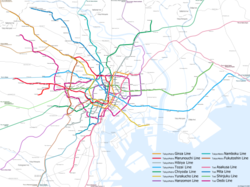Tokyo subway

Top: The logo of Tokyo Metro
Middle: The logo of Tokyo Metropolitan Bureau of Transportation operating Toei Subway Bottom: Toei 6300 series (left) and Tokyo Metro 10000 series (right) trains at Musashi-Kosugi Station |
|||
| Overview | |||
|---|---|---|---|
| Locale | Tokyo, Japan | ||
| Transit type | Rapid transit | ||
| Number of lines | 13 | ||
| Number of stations | 285 | ||
| Daily ridership | 8.7 million | ||
| Operation | |||
| Began operation | December 30, 1927 | ||
| Operator(s) | Tokyo Metro, Tokyo Metropolitan Bureau of Transportation (Toei) | ||
| Technical | |||
| System length | 304.1 km (189.0 mi) | ||
| Track gauge | 1,067 mm (3 ft 6 in) (1,435 mm for Ginza, Marunouchi, Toei Asakusa & Toei Ōedo Lines, 1,372 mm for Toei Shinjuku Line) | ||
|
|||
The Tokyo subway (東京の地下鉄 Tōkyō no chikatetsu?) is a part of the extensive rapid transit system that consists of Tokyo Metro and Toei Subway in the Greater Tokyo area of Japan. While the subway system itself is largely within the city center, the lines extend far out via extensive through services onto suburban railway lines.
There are two primary subway operators in Tokyo:
As of 2015[update], the combined subway network of the Tokyo and Toei metros comprises 285 stations and 13 lines covering a total system length of 304.1 kilometers (189.0 mi). The Tokyo Metro and Toei networks together carry a combined average of over eight million passengers daily. Despite being ranked first in worldwide subway usage, subways make up a small fraction of heavy rail rapid transit in Tokyo alone—only 274 out of 882 railway stations, as of 2007. The Tokyo subway at 8.7 million daily passengers only represents 22% of Tokyo's 40 million daily rail passengers (see Transport in Greater Tokyo). Other urban commuter rail systems include Keihin Electric Express Railway, Keio Corporation, Keisei Electric Railway, Odakyu Electric Railway, Seibu Railway, Tobu Railway and Tokyu Corporation.
...
Wikipedia

